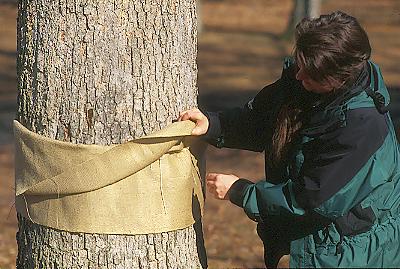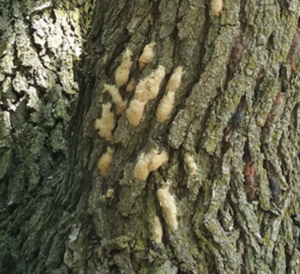The Town of Erin does not have a LDD (gypsy) moth spraying program. Here are some helpful tips and information on how you can tackle them. Further resources are available from:
The Lymantria dispar dispar, (LDD) commonly known as the European gypsy moth is a major forest pest concern because the caterpillar, or larva stage of the insect, eats the leaves of trees, defoliating them which makes them more susceptible to disease and damage from other insects, like tent caterpillars. Continued defoliation of trees can lead to their decline and eventual death.

A single LDD moth caterpillar can eat an average of one square metre of leaves.
What can you do to stop the spread on your property?
Help manage the LDD moths by following these techniques:
May to July: Hand Pick Caterpillars
Handpicking caterpillars is most effective on small newly planted trees, shrubs and plants infested with gypsy moth. If possible, gently shake the tree so caterpillars fall from the leaves. Thoroughly inspect the remaining foliage, branches, and trunk for caterpillars and using gloves, pick them off your tree. Fallen and collected caterpillars should be placed and left to soak in soapy water to destroy them.
June to August (Larger Caterpillar Stage): Burlap Banding
Once caterpillars grow to about an inch (2.5 cm) in length by mid-June, they will move down the trunk to seek shelter from predators and heat during the day. Reduce the number of larvae on the trees in your yard by trapping them.
Required Supplies:
- Burlap cloth
- Twine or rope
- Bucket of soapy water. Dish soap works well

Step-by-Step Instructions
- Wrap and secure a piece of burlap cloth around the stem/ trunk of your tree.
- Tie twine or rope around the center or slightly below the center of the burlap.
- Drape the burlap cloth over the twine or rope so there is an overhang where the caterpillars can crawl underneath to seek shelter during the day.
- Check the trap by lifting the overhanging cloth every afternoon and collect any hiding caterpillars.
- Put them into a bucket of soapy water for a few days to destroy them.
July to August (Female Moth Stage): Burlap Wrapping
To trap female moths, wrap burlap lower on the trunk of the tree to trap the female moth (which are unable to fly) before it crawls up the tree and lays eggs. This is the same method used for the larger caterpillar stage. Once captured, drown the moths in soapy water.
August to May: Egg Mass Removal
Survey your property for egg masses and scrape them off surfaces into soapy water to destroy them.
Required Supplies
- A flat object such as a butter knife or plastic paint scraper
- Catchment container or bag to collect the egg masses

- Bucket of soapy water. Dish soap works well.
Step-by-Step Instructions
- Place your catchment container below the egg mass
- Use your scraper tool to remove the egg mass from the surface. Ensure that all eggs are scraped. Try not to leave any residual eggs in bark ridges or crevices.
- Empty the contents of your catchment container of bag into a bucket of soapy water.
- Leave eggs sitting in the bucket for a day or two, then dispose of the contents.
Egg masses can be located high up in trees. Care needs to be taken if trying to access anything aloft, especially is using ladders. Some private tree care companies can be hired to provide this service at heights.
Year-Round: Consult with a Professional
Consult an arborist for treatment options or contact your local garden supply store for the availability of materials.
 Skip to main content
Skip to main content